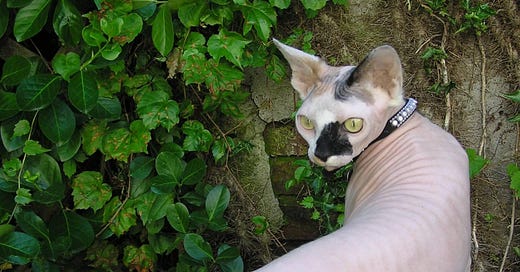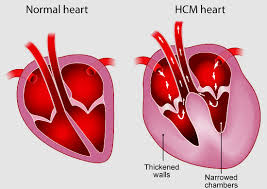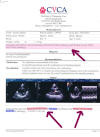Hypertrophic Cardiomyopathy (HCM)
Part 1 - Why Heart Scans are Important for ALL Sphynx Owners, Not Just Breeders.
PART 1 OF 4 in the HCM in Sphynx Series
A bit about me: I have shown and bred Sphynx since 2003 to current date. My breeding cats have been scanned by board certified cardiologists since 2004. I have volunteered to be the HCM Clinic Coordinator for discount clinics at CVCA in Maryland for over 15 years now. I have, and always will, actively work hard to mitigate this terrible, devastating disease in Sphynx including regular scanning, pedigree study; public, breeder & owner education about HCM, and currently involved in a study.
Hypertrophic Cardiomyopathy (HCM) is the most common heart disease found in all domestic cats.
Per several studies, 1 in 7 cats has HCM. The rate is much higher in Sphynx. This is a generally a genetic disease that can happen at any time to any breeder regardless of scanning and precautions. HCM is a thickening of the heart's left ventricle wall. Many cats that have heart conditions show no outward symptoms (ie heart murmur) when checked by a by a non-specialist vet and this is why it is critical to scan your Sphynx.
Proactive Sphynx breeders take their breeding cats regularly to be scanned by a board certified cardiologists. Breeder clearances help mitigate HCM by removing any cats with heart disease from breeding programs. This is the gold standard tool we have right now, however it is not a guarantee that the lines are free from HCM. The reason for this is the HCM gene(s) has variable expression and can express itself at any time. Make sure the breeder you are working with checks the pedigrees as well. That is equally important.
"Why should I spend the money to take my apparently healthy Sphynx cat to the cardiologist?"
Sphynx have a higher than normal percentage affected by hypertrophic cardiomyopathy (HCM). HCM is a thickening of the left ventricle wall of the heart. Many cats that have heart conditions show no symptoms (ie heart murmur) when checked by a non-specialist vet, or by your regular vet. If you want to be proactive it is a good precaution to ensure you are breeding healthy cats or your pet cat is heart healthy. This exam not only checks for HCM, but other heart abnormalities as well.
This is by no means a perfect tool but it is the best tool we have right now. Even if the result of the exam is normal - HCM and other heart abnormalities can appear at any time in the future. The pedigree must also be consulted depending on the results.
Why can't I just take my Sphynx to a regular vet?
A board certified veterinary cardiologist is a licensed veterinarian who has obtained additional training in veterinary cardiology and has been certified by the American College of Veterinary Internal Medicine (ACVIM). They must go through years of rigorous training and keep their skills up to date by participating in continuing education programs. If the cat is not scanned by a board certified cardiologist, the report is not worth anything. **Please do not accept scans done by "regular" vets. Some breeders do use regular vets and that is not acceptable.
Now, you have decided to take your cat(s) for a scan. What is next?
The first step is to find a BOARD CERTIFIED cardiologist or ensure the cat you are purchasing was scanned by a board certified cardiologist.
1.) Board Certified cardiologists use "DACVIM" after their name. Click on HCM scan report image below to enlarge to see. Note the highlighted areas with arrows.
2.) You can check the list yourself on the official ACVIM website
Find A Board Certified Cardiologist (click the link)
3.) You should be able to contact the cardiologist to verify the fact the cat was scanned by them and scanned "normal".
Lastly, it is important to note that HCM is a complex disease that can appear at any time. Some cats are scanned "normal" throughout their entire life but produce HCM positive kittens. They have an HCM mutation but never express it. Yearly scanning is currently the best tool we have to ensure healthy hearts - but it is not foolproof. Unfortunately, even with scanning, any kitten, even from a breeder that scans and does their best, can become HCM positive. You will lower your risk if you use a breeder that does scan and watch the pedigrees.
What to expect at the exam:
The cardiologist will start with a complete physical exam. Heart murmurs can detected with a stethoscope. The cardiologist will also check your pet‘s weight, pulse rate, the color of the mucous membranes, organs, as well as examine him or her for any physical evidence of fluid buildup in the abdomen or extremities.
Cardiac Ultrasound (Echocardiogram): This test allows the visual examination of the interior of the heart, its valves, and its surrounding structures via ultrasonography. It is a sophisticated diagnostic tool.
Doppler Echocardiography: A more advanced form of ultrasonography, this sophisticated technology can enhance the diagnostic information gained from standard two-dimensional ultrasounds. In short, sound waves are bounced off of moving red blood cells in order to determine the movement and force of blood flow within the heart. There are three types of Doppler ultrasound: continuous wave, pulsed wave, and color flow.
This test is fairly easy and the cat is placed on a table with a hole in it and then the ultrasound is placed on the heart from below. Sometimes it requires the cat to be restrained, but there is no sedation process.
The Results:
The cardiologist will give you an extensive report that states whether your cat is: normal, equivocal or abnormal. Then, there will be a medical plan put into place to help your cat manage the disease.
Here is an example of a cardiologist report from one of my cats:
Heart Scan Report Example (click link)
Not always are the results black and white as we wish they would be. Sometimes they need to see the cat once more and see if an anomaly is "normal" for that cat and not a sign of HCM or another heart issue. When diagnosing HCM, a normal heart has a wall thickness under 5.0mm. Then, there is a grey area between 5.0mm and 6.0mm. The cardiologists use their knowledge and other factors (such as size of the cat) as they are looking at the heart to determine the result. If the left ventricle wall thickness if over 6.0 mm the cat will be diagnosed with HCM.
EXAMPLES:
Example 1: My cat Kayla - picture of health. When I took her to be scanned in 2007 she was diagnosed by the cardiologists "NOT FOR BREEDING" because she has mitral valve dysplasia. Also taken into consideration that her mother had it more mildly than she did. The cardiologists told me that her offspring could have it worse than Kayla and require medications. If I had not taken her to the cardiologist, I would have never known. Please note, she does not have HCM, but still has a genetic heart defect.
Above: BW, RW, SGCA, GP Citizenkat Shangri-La aka Kayla
Example 2: My cat Claire- also the picture of health. She was examined the same day in March as Kayla at CVCA. I had already altered her because of a risky pedigree. At the clinic, she was deemed perfectly normal. While disappointed that I had to alter Kayla, I was happy that my two girls were normal and appeared to live normal happy lives. 6 months later on Sept 15, I thought saw Claire sleeping. I went over to touch her and she was cold. I almost did not get a necropsy done - but then I realized I had to know. Sure enough, she had a cardiac arrhythmia and her heart was 1.5 times larger than it should have been for a cat her size.
Example 3: A male cat that a friend and I purchased was scanned at 13 months. He appeared to be in excellent health. We were shocked when he positive for HCM. Both his parents had been scanned clear. Thankfully, he was never used in a breeding program to perpetuate this genetic problem. Sadly, in July 2012, just 3.5 years old, Earl passed away in a loving pet home.
Conclusion:
My personal examples show how important it is to take breeding Sphynx to the cardiologist, but it also demonstrates that breeders cannot rely on the scan alone. Responsible breeders must remain cautious in breeding programs and consider the pedigree as well.
Frequently Asked Questions:
I heard the Ragdolls and Maine Coons have an HCM DNA test? What about the Sphynx?
After waiting over a decade for a test, in December 2020, a Sphynx HCM DNA test was released. Responsible breeders were excited at the prospect of having a tool that would reduce HCM in the breed.
However, 3 subsequent, peer reviewed studies have shown the mutation is not causal. Therefore, the test is not helpful. It is sad as many of us, including myself worked to have an DNA HCM negative cattery. We had hoped this would help.
My Sphynx cat has HCM but both parents are scanned "normal". How can this be?
HCM has a variable expression and not all cats who have HCM show symptoms and the age which it shows it can be varied.
As a pet owner, how often should I scan and; Why should I scan?
I tell all my pet adopters they should be scanning at ages: 1. 3.5, 5.5, 7.5 years old.
These recommendations can vary by new information about pedigree (ie a parent scans positive) or if your cat is showing signs of heart disease (ie develops a murmur, seems tired). Some people are more comfortable scanning more frequently.
One of the most important reasons to scan is to possible prolong its life. Generally a cat that is asymptomatic has a much better chance of living longer with proper medicines. The medicines can help the heart work better and therefore help prevent the left ventricle wall from thickening. A cat that is symptomatic may already have the heart muscle working hard and it may not be able to be treated as easily. It can be scary to scan your Sphynx and it can be a hard diagnosis to take if your cat is positive. However, by scanning your Sphynx - it can extend your kitty's life a great deal.
I live really far away from a board certified cardiologist, or, I am financially strapped at the moment, what can I do?
You can request an IDEXX ProBNP test from your regular vet at your cat’s annual exam. From the IDEXX website: Cardiopet ProBNP provides a that quantitative assessment of canine and feline heart health by measuring the concentration of NT-proBNP, which is released by cardiac myocytes in response to stretch and stress.
This test has become controversial and some recommend not doing it. However per the most recent veterinary conference at NCSU in April 2025, this is a good test. It was developed to meet the needs of pet owners and veterinarians. I personally have not heard of any cat with a high ProBNP not having heart disease. If your cat does have a high number, you will still need to see a cardiologist.
The echocardiogram is still the gold standard.
Most Sphynx will not scan positive the first year they are scanned. Why shouldn't I wait to scan later and save money?
The first scan is a baseline exam and this exam will serve as the basis for future scans to determine if there are changes. Also, it does mitigate damage done if a cat has very early onset of HCM because then the cat is altered and not used in a breeding program.
As a breeder or a prospective pet owner, what should I look for? What should I avoid?
The breeder should be scanning regularly and know the pedigrees. Everything must have balance, so you still to purchase your kitty from someone who pays attention to overall health, immunity and type. If all aspects of good animal husbandry are not addressed, in my opinion, it is not proper.
Some breeders will say "HCM free". What does that mean?
This is a marketing statement used to garner sales. There is no such thing as "HCM free". Only "HCM negative" and it is only good at the time of the scan. .
Ok, I looked in the public databases there are and I see the breeder I want to purchase a cat from has an HCM positive cat. Should I purchase from them or avoid that breeder?
If the breeder mitigates the damage that makes them a good ethical breeder. Remember, the breeders that care are going to know more about their lines and it might APPEAR they have more HCM when in fact it is just the fact they care and keep in touch and report issues. Basically, you have to look at the whole picture.
My Sphynx was diagnosed with HCM, what should I do?
First and foremost, concentrate on getting your kitty the best care. Secondly, you should inform the breeder immediately and send a copy of the report to the breeder. This way the breeder has the information to mitigate any health issues. If your regular vet diagnosed it, that is not a proper diagnosis. Your cat needs to see a board certified cardiologist. Only a board certified cardiologist should be diagnosing heart issues.
A responsible ethical breeder will want pet adopters to keep in touch with them so that they know how their program is doing and if they need to make changes to it.
IS THERE HOPE?
Yes!
There is a new drug called Rapamycin that may reverse HCM in some, not all, cats! It has been approved for release in july/August 2025
There are still studies being completed to try to find the HCM mutations in Sphynx.





